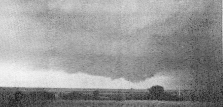C. The Life Cycle of a Tornado:
In Figure 7, we are looking west and can see the typical pattern: Rain Free Base,
Wall Cloud, and Precipitation Area. The Wall Cloud is located in the southwest quadrant of
the storm, and formed 30 minutes prior to the tornado. In Figure 8, what appears to be a
funnel cloud is visible under the left portion of the Wall Cloud. In fact, this is a
tornado because damage was occurring at the ground even though it is too tar away to see
the surface debris. In such a situation, you should properly report this as a funnel
cloud, along with the fact that it Is too far away for you to determine if it is on the
ground. Report what you see, along with any additional remarks which would make the report
more useful. In Figure 9, the circulation becomes visible all the way to the ground. The
thin, "needle-tipped" shape is common for a tornado in this early stage.
The tornado reaches its mature stage in Figure 10, with its width at the surface expanding
to ¼ mile. Note the Tail Cloud forming to the right. We have changed position in Figure
11 and are looking southeast as the tornado moves away from the town of Union City,
Oklahoma. The tornado is shrinking rapidly into the "rope stage," but Is still
very destructive. During the latter portion of a tornado's life, it is common for it to
decrease in size (not necessarily in intensity) and become increasingly tilted. |
|
FIGURE 7
 |